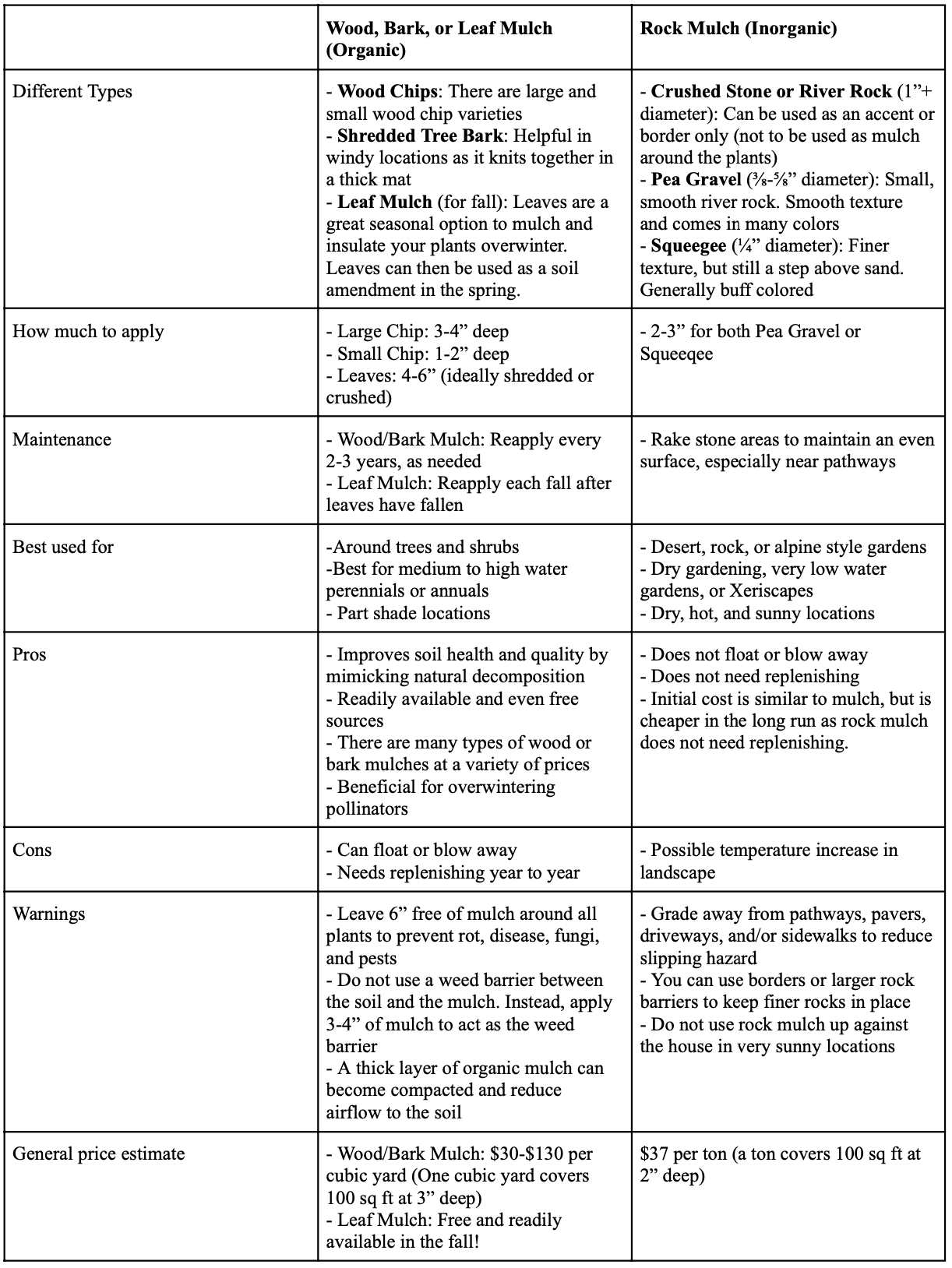Let’s discuss one of the seven principles of Xeriscaping that we get the most questions about – mulch! For clarity’s sake, we are talking about mulches that fit into a landscape with low-water plants. We are NOT encouraging anyone to replace their lawn with only wood mulch or rock mulch! We are talking about Xeriscaping— not “zero-scaping.” Learn more about the other xeriscaping principles here.
 What is mulch?
What is mulch?
Mulch is a protective layer put on top of bare soil. Soil amendments on the other hand (the second principle of xeriscaping) are incorporated into the top few inches of soil with the intention of improving soil quality. When it comes to mulches there are two basic options: organic and inorganic, otherwise known as plant matter and non-plant matter. Organic mulches include wood chips, bark, straw, grass clippings, leaves, pine needles, or even dead weeds. Inorganic mulches are typically some sort of rock layer.
Mulching is not a new landscaping concept. Mulching actually mimics the natural process of an ecosystem’s lifecycle. Plants die back or drop foliage in fall and this plant matter then decomposes over the winter, providing much-needed nutrients to the plants again come spring. Mulching is natural and necessary for healthy soils, healthy plants, and healthy gardens!
Why mulch at all:
- Suppresses weeds
- Reduces evapotranspiration. More of the water applied to plants gets to their roots, rather than evaporating
- Reduces soil temperature variations. Mulch keeps the soil cooler in summer and warmer in winter, helping to protect plant roots.
- Controls erosion
- Improves drainage of water from the soil surface to plant roots.
- Adds texture and improves aesthetics
- Helps build organic matter in soil. “Organic matter in soil, largely carbon from decayed plant and animal matter, holds plant nutrients, improves soil texture and structure, and helps moisture levels stay just right for plants.”
What are my mulch options?
If you have ever googled “types of mulch” you may have noticed that there are some opposing views about which option is best. In gardening, there is the concept of selecting the “right plant for the right location” and we like to think that this applies to mulch as well! Both organic and inorganic mulches have their appropriate locations in a landscape. Let’s get into these options to determine which is best suited for your Colorado perennial garden!
Ultimately, you as the gardener get to decide which mulch – organic or inorganic – works best for your garden, your plants, and the aesthetic you are going for. We recommend trying a bit of both and seeing how it goes! After all, the thing about gardening is that it’s a bit of an experiment.
NOTE: Fallen leaves are a wonderful seasonal mulch option! Leaf mulch can help insulate your plants overwinter, and then becomes a readily available soil amendment in the spring. Leaf mulch decomposes much more quickly than other mulch options, so its a great way to add nutrients into your garden. Additionally, leaf mulch provides essential habitat for overwintering pollinators.
A note about weed barriers
Weed barriers may include plastic, permeable landscape cloth, newspaper, or cardboard. We suggest no weed barrier at all beneath your mulch layer in home landscapes – no matter the kind of mulch – since it tends to create more problems than it solves.
Plastic is a no-go altogether for a number of reasons. It doesn’t allow plant roots to grow sufficiently, it heats up the soil, it keeps out beneficial ground-nesting pollinators, and it prevents moisture and air from getting into the soil. The fibers in landscape cloth, though initially permeable, fill with sediment, dirt, and debris and end up creating a non-permeable layer between the mulch and the soil. Not only leaving the soil beneath starved for air and moisture, but also creating an environment for weeds to germinate on top of the cloth. See this video about the issues with landscape cloth.
Even more natural materials like newspaper and cardboard, though they break down more quickly than the last two we spoke of, may also keep air and moisture from getting into the soil. After all, wood mulch’s main benefit is that it decomposes to build soil health and this will not happen if there is a barrier between it and the soil! A 3-4” layer of mulch should be sufficient for slowing weed growth while still encouraging great soil health and a healthy backyard ecosystem.
Weed barriers may prove beneficial in very small sections of your yard. They can be helpful for things like lining the ground beneath pathways, but they shouldn’t be used in large areas where you want plants to thrive.
Sources and Other Resources:
Xeriscape Principles:
Xeriscape Mulches:
https://planttalk.colostate.edu/topics/water-wise-xeriscape/1905-xeriscape-mulches/
Mulches for Home Landscapes:
https://extension.colostate.edu/topic-areas/yard-garden/mulches-for-home-grounds-7-214/
Soil Fertility Management for Sustainable Development:
Western Best Practices:
https://plantselect.org/wp-content/uploads/2020/10/Western-Best-Practices-FINAL.pdf
Weed Barriers:
https://www.youtube.com/watch?v=ARK11ZxeGq4&list=PLF923A9DD3BD61E42&t=6s













